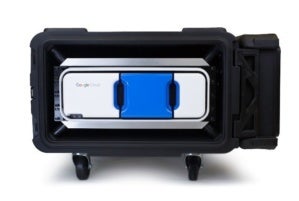Google is adding to its cloud storage portfolio with the debut of a network attached storage (NAS) service.
Google Cloud Filestore is managed file storage for applications that require a file system interface and shared file system for data. It lets users stand up managed NAS with their Google Compute Engine and Kubernetes Engine instances, promising high throughput, low latency and high IOPS.
The managed NAS option brings file storage capabilities to Google Cloud Platform for the first time. Google’s cloud storage portfolio already includes Persistent Disk, a network-attached block storage service, and Google Cloud Storage, a distributed system for object storage. Cloud Filestore fills the need for file workloads, says Dominic Preuss, director of product management at Google Cloud.
“You can only attach one VM to Persistent Disk. With [Google Cloud Storage] object storage, you can have a bunch of things read it, but it doesn’t have the transactional semantics of a file system. Cloud Filestore is the intermediate of those two: you can have multiple VMs speak to it, and it has transactional properties of a file system.”
To make it easier for companies to move data into its cloud storage, Google also announced the availability of Transfer Appliance. The rackable storage server is designed to move large amounts of data out of enterprise data centers and into Google’s cloud.
Google ships the appliance to customer sites where the data is transferred at high speeds into the appliance before it’s sent back to Google to complete the data transfer to the customer’s storage system in the Google cloud. (AWS Snowball is Amazon’s version of a similar appliance.) Google first shared details of its Transfer Appliance last summer, and it’s now generally available in the U.S.

Transfer Appliance is aimed at companies that want to move large amounts of data to Google Cloud Platform and don’t want to rely on traditional network links. It’s recommended for companies that have to move more than 20TB of data or data that would take more than a week to upload, Google says.
Rounding out Google’s news is the launch of its latest cloud region in Los Angeles. LA is the fifth U.S. site in Google’s global cloud platform network and the 17th site worldwide.
Google put a Hollywood spin on its spate of news, emphasizing that media and entertainment are among the expected beneficiaries of Google’s regional expansion to LA. One example is The Mill, a global visual effects studio that works on short-form content like commercials and music videos in addition to larger projects.
“A lot of our short-form projects pop up unexpectedly, so having extra capacity in-region can help us quickly capitalize on these opportunities,” said Tom Taylor, head of engineering at The Mill, in a statement. “The extra speed the LA region gives us will help us free up our artists to do more creative work.”
Google Cloud Filestore
Media and entertainment companies are also among the targets for Cloud Filestore, which is geared for organizations with lots of rich unstructured content and applications that require low latency and high IOPS, such as content management systems, website hosting, render farms and virtual workstations.
Film studios and production shops are always looking to render movies and create CGI images faster and more efficiently, Preuss says. Cloud Filestore offers an alternative to using on-premises machines and on-premises files for rendering.
“Media and entertainment have a number of distributed workloads. The most common one is render farms, or render workloads,” Preuss says. “You’ve spent several years, let’s say, developing a movie or an animated movie, and the last step is to have a big compute job to either render the animation or render the special effects or do some post processing on the movie. You need to be able to have a number of VMs working on that data to do updates. That’s a very common use case for a managed NFS offering like Cloud Filestore.”
Google offers two pricing tiers for Cloud Filestore. The Premium tier is $0.30 per GB per month, and the Standard tier is $0.20 per GB per month (pricing varies slightly in some regions). Cloud Filestore Premium is designed to provide up to 700 MB/s throughput and 30,000 IOPS, regardless of instance capacity. For Standard instances, performance scales with capacity; peak performance is available at 10TB and above. Filestore will release into beta next month.
Google Transfer Appliance
Companies can request a Transfer Appliance directly from the Google Cloud Platform console. The appliance comes in two configurations: a 100TB model priced at $300, and a 480TB model priced at $1,800. If customers compress data, it typically doubles the raw capacity, according to Google. Express shipping runs roughly $500 for the 100TB appliance and $900 for the 480TB model. The device is designed to fit in a standard 19-inch data-center rack.
Some typical use cases Google cited include: migrating part or all of a data center to the cloud; kick-starting a machine learning or analytics project by transferring test data and staging it quickly; moving large archives of content such as creative libraries, videos, images, regulatory or backup data to cloud storage; and collecting data from research bodies or data providers and moving it to Google’s cloud for analysis.
Schmidt Ocean Institute is an early adopter of Transfer Appliance. The nonprofit foundation owns and operates the Falkor, an oceanographic research ship with a 100TB Transfer Appliance installed onboard.
“We needed a way to simplify the manual and complex process of copying, transporting and mailing hard drives of research data, as well as making it available to the scientific community as quickly as possible,” said Allison Miller, research program manager at Schmidt Ocean Institute, in a statement. “We are able to mount the Transfer Appliance onboard to store the large amounts of data that result from our research expeditions and easily transfer it to Google Cloud Storage post-cruise. Once the data is in Google Cloud Storage, it’s easy to disseminate research data quickly to the community.”